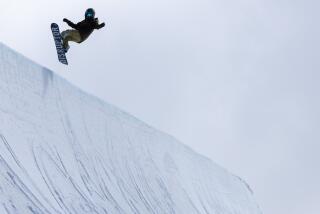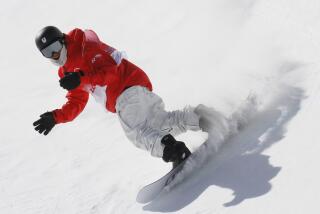‘If You Can Walk, You Can Snowshoe,’ More and More Do
- Share via
WATERVILLE VALLEY, N.H. — Susan Brasso got tired of being a ski widow, stuck at home on winter weekends while her husband and son frolicked in the mountains.
She doesn’t ski downhill or cross-country, but last month she went along with her family and discovered one of the fastest growing winter sports--snowshoeing.
“I’ve never done it before, but I think I’ll do it again tomorrow,” she said after trying it for the first time for 1 1/2 hours.
Elly and Brian Hawkins of Coran, N.Y., are two other new disciples of this centuries-old method of snow travel. After traveling from Long Island to Waterville for six years to cross-country ski, last year they rented snowshoes for the first time. This year, they bought them.
“You don’t need a lesson; there’s not much technique. You just need a little endurance,” Elly said. “It’s a little more than walking.”
It’s no longer like tying a couple of heavy wooden tennis rackets to your feet. Now snowshoes are made of lightweight aluminum with user-friendly bindings that take almost any hiking boot. That ease has helped make snowshoeing a winter sports alternative.
“We like to say that within five steps you’re an expert,” said Kathy Murphy, marketing director for Tubbs Snowshoes of Stowe, Vt., one of the country’s oldest and biggest snowshoe manufacturers.
“If you can walk, you can snowshoe. It is that easy to learn.”
Elly and Brian Hawkins now prefer snowshoeing to cross-country skiing.
“In cross-country, you have to concentrate so much you don’t have time to enjoy the scenery,” Elly said. Going up hills also is easier because of the crampons on the snowshoes, Brian said.
And you can do it anywhere. Snowshoers can walk out the door of their house, tour a park or hike the deep woods with no groomed trails necessary.
“You don’t have to go that deep into the woods to have the beauty around you,” Elly said.
Depth of the snow doesn’t matter; there’s no sinking.
“They really do work,” Elly Hawkins said. “You walk on top of the snow.”
Those advantages have persuaded thousands of people to give snowshoeing a try in recent years. Murphy said snowshoeing is second in growth to snowboarding as a winter sport.
Tubbs’ sales doubled from 1990 to 1994, when a study by the National Sporting Goods Association showed there were 440,000 snowshoers nationally, Murphy said. The number grew 45%, to 640,000, in 1995.
Matthew Publicover, store manager for MVP Sports in Bedford, N.H., said his store started stocking the new aluminum model about three years ago “and they blew out of here.”
Now they stock them regularly.
“It’s not a test anymore,” Publicover said. “They’re here to stay. We sell 100% of what we have.”
More ski areas also are offering snowshoe rentals due to the demand. Paul Mikalaukas, who runs the cross-country trails at Waterville, said snowshoe rentals now represent about a quarter of his business.
“There’s a general trend toward wellness and fitness . . . and walking for fitness is extremely popular, and showshoeing is about the most direct translation from walking as a sport,” he said.
Paul Giblin, who runs Great Glen at Mount Washington, said his area has started offering wildlife tours on snowshoes. Great Glen and Waterville both offer evening hikes under the stars.
More to Read
Sign up for The Wild
We’ll help you find the best places to hike, bike and run, as well as the perfect silent spots for meditation and yoga.
You may occasionally receive promotional content from the Los Angeles Times.






